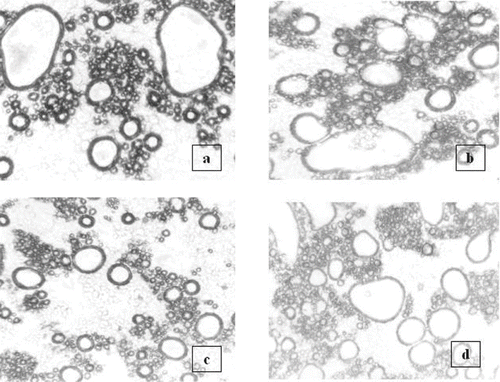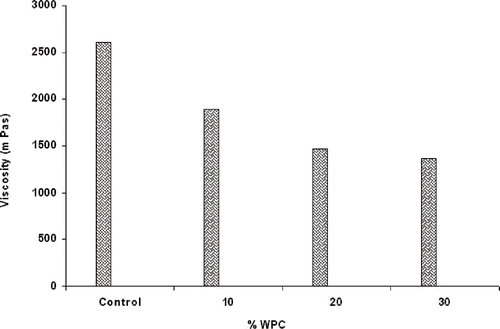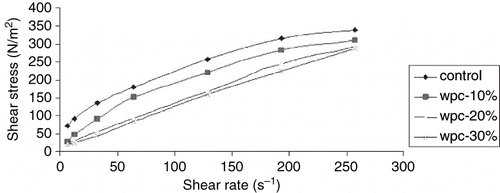Abstract
Effect of substitution of wheat flour with whey protein concentrate (WPC) at the level of 10, 20, and 30% as an egg replacer and its influence on physical properties of cake batter and quality characteristics of eggless cake were studied. The apparent viscosity of the eggless cake batter decreased with the increase in the level of WPC. The evaluation of eggless cake batter for density showed that incorporation of WPC decreased the batter density. The photomicrographs of eggless cake batters with WPC showed an increase in number of air cells and even distribution when compared with the control indicating lighter batter. Eggless cake with 20% WPC was rated the best.
INTRODUCTION
Baking industry is probably the largest of the processed food industry in India. The annual production of bread, buns, and cakes in the country is estimated around 15.2 lakh tonnes.[Citation1] Among the bakery products, cakes being very popular occupy a special place in Indian bakeries. Egg is the vital ingredient in the preparation of cake. Use of eggs has enabled bakers to introduce colour, flavour and texture to their products. Eggs play a unique functional role in bakery formulae.[Citation2] Johnson[Citation3] reported that freshly processed bovine blood plasma was effective in replacing all egg white or whole egg in high ratio layer cakes. Lee et al.[Citation4] in their study stated that the use of fresh, frozen and spray-dried bovine plasma could replace egg whites in high–ratio, white layer cakes resulting in cakes with similar volume, texture, and appearance. Replacement of 1.0 part of egg white protein with 1.1 part of plasma protein gave cakes of equivalent quality. A blend of hydrolysed plasma and beef stock could replace 50% of the egg in devils food cake without affecting symmetry or shrinkage and with only a slight decrease in volume Lee et al.[Citation5] Soy flour has been used to partially replace eggs in sugar cookies, fancy muffins, lean muffins, chocolate cake, and pancake.[Citation2] The reasons for replacing egg with whey protein concentrate is related to the functional properties of whey proteins. Whey proteins apart from being highly nutritious have very good functional attributes such as water binding, viscosity, foaming, emulsifying, gelling, and solubility.[Citation6] There are numbers of reports on the studies of whey proteins. Firebaugh and Daubert[Citation7] identified a derivatization procedure for the production of a cold gelling whey protein isolate. Morison and Mackay[Citation8] studied the viscosity of lactose and whey protein solutions. The objective of this article was to investigate the influence of whey protein concentrate on the rheological and baking properties of eggless cake.
MATERIALS AND METHODS
Wheat flour and crystal sugar were purchased from the local market. Shortening (Margarine, Hindustan Lever Ltd., Mumbai, India), baking powder (single and slow acting type, acid source sodium aluminium sulfate, Hindustan Lever Ltd.), salt (S.D. Fine Chem Ltd., Mumbai, India), whey protein concentrate (Procon 3700, whey protein 70, Mahaan Proteins Ltd., New Delhi, India) and pineapple essence (Bush Boake Allen Ltd., Chennai, India) were used.
Cake Formulation
A standardized formulation based on the preliminary lab trials was used for the study. Wheat flour was substituted by WPC at 10, 20, and 30% levels. The following formulation was used wheat flour : WPC (g) - 100 : 0, 90 : 10, 80 : 20, 70 :30, shortening (g) – 20, crystal sugar (g) – 70, salt (g) – 0.5, baking powder (g) – 3.0, pineapple essence (g) – 0.40, water (g) – 115. The dry ingredients excepting WPC were combined and sifted well. Sugar, fat, and essence were creamed for 2 min in a Hobart N-50 mixer (Ontario, Canada) at 173 rpm. WPC was added and mixture was whipped for 3 min at 173 rpm. Finally, flour and water were added, mixed at 58 rpm for 2 min and at 173 rpm for 2 min until homogeneous. The batter temperature was 26°C. Eggless cake batter (450g) was transferred into a cake pan and baked at 200°C for 60 min using the oven (APV, Queensland, Australia).
Batter-specific Gravity
Specific gravity of eggless cake batter was calculated by dividing the weight of a standard measure of the batter by the weight of an equal volume of water.
Batter Microscopy
The freshly prepared cake batters of the control and with different levels of WPC were examined by placing the batter roughly 20 µm thick on a slide and squashing with a thin cover slip The samples were then observed under a phase contrast microscope (Model BX 40, Olympus, Optical Co. Ltd., Hachoji, Japan) with a magnification of 10X.[Citation9]
Batter Viscometry
The shear stress of fresh eggless cake batter was determined using a viscometer (Model HBDV-III, Brookfield. Viscometer, Brookfield Engineering Laboratories, Stoughton, M.A., U.S.A.) fitted with Din Adapter and DAA spindle 86 at shear rates 6.45, 12.9, 32.25, 64.5, 129, 193.5, and 258 s−1. The apparent viscosity of samples was measured at 64.5 s−1 shear rate.
Cake Measurements
Cake volume was measured by the rapeseed displacement method.[Citation10] The sensory evaluation and measurement of the texture were carried out using American Association of Cereal Chemists Methods.[Citation11]
Statistical Analysis
Experiments were carried out on 4 consecutive days. Statistical analysis of data was done by using analysis of Variance (ANOVA) on 4 experimental groups with 4 replicates each. The experimental groups were then separated by using Duncan's new multiple range test as described by Steel and Torrie.[Citation12]
RESULTS AND DISCUSSION
The WPC used for the study had the following constituents on dry basis ash 6%, proteins 65%, and total lipids 1%. The data on the effect of WPC on quality characteristics of eggless cake is presented in .
Table 1 Effect of different levels of WPC on the quality characteristicsFootnote∗ of eggless cake
Batter—Specific Gravity
The batter specific gravity is a measure of amount of air incorporated in a batter. The incorporation of WPC in eggles cake batter decreased the batter specific gravity. The control eggless cake batter had a specific gravity of 1.40g/cm3 (), whereas eggless cake batter with 10, 20, and 30% WPC had a specific gravity of 1.10, 0.85, and 1.20 g/cm3, respectively, which were significantly lower (p ≤ 0.05). This indicates that the WPC batters were lighter because of better air incorporation. This could be attributed to foaming properties of WPC. Undenatured whey proteins are excellent foaming agents.[Citation13] Variable foaming capacities have been reported for WPCs. By opening up globular structures of α – lactalbumin and β – lactoglobulin and exposing the –SH groups in the latter, the stability of whey protein foams may be increased without increasing overrun.[Citation14] A significant decrease in batter density was noted in the case of 20% level of WPC replacement. Funk et al.[Citation15] reported that the rheological studies on batter viscosity indicated that thinnest batters were most stable when the performance of frozen, foam-spray, freeze, and spray-dried eggs in cakes containing fat were compared.
Batter Microscopy
The photomicrographs of eggless batters containing different levels of WPC are presented in to 1d. is the photomicrograph of the control cake batter in which large, small and very small air bubbles are seen. The air bubbles are not uniformly distributed throughout the batter. The micrograph of eggless cake batter with 10% WPC () showed an increase in the number of small and similar sized air bubbles which are distributed in the batter relatively better than the control. Many small sized air bubbles are predominantly seen in the micrograph of batter containing 20% WPC. The air bubbles are of uniform size and appear evenly distributed throughout the batter (). is the micrograph of batter containing 30% WPC. It showed dominant large sized air cells along with small and very small air cells. The air cells were uneven sized and distribution in the batter was of non-uniform nature. The very small cells appeared clustered.
Batter Viscometry
The rheological properties of eggless cake batter as influenced by different levels of WPC are presented in and . As the percentage of WPC increased from 10–30% in eggless cake batter, there was a decrease in the apparent viscosity of the batter (). Morr[Citation16] reported that WPC generally produced higher foam expansion but lower viscosity and stability values than for liquid egg white protein. The shear stress and shear rate relationship of eggless cake batter as influenced by WPC addition is presented in . The shear stress increased with increasing shear rate indicating that the eggless cake batter exhibited shear-thinning behaviour. This behaviour was observed at all levels of WPC.
Effect of WPC on Cake Quality
The data on the effect of different levels of WPC on the quality of eggless cake are presented in . The maximum improvement in specific loaf volume of eggless cake was brought about by replacement of wheat flour with 20% WPC. The height of the eggless cake was comparable with cake made using egg. Good air incorporation and formation of a homogeneous emulsion of cake batter are crucial for a good quality cake. The increased volume of the eggless cake obtained may be due to the foaming and emulsifying properties of WPC. The whey proteins are good surface active agents and emulsifying property is due to the ability of protein to reduce the interfacial tension by forming a membrane rapidly around the oil droplet to prevent coalescence, flocculation, creaming, and oiling off.[Citation17] Whey protein concentrates have good emulsifying capacity. There is significant correlation between emulsion capacity and soluble β – lactoglobulin.[Citation18] The specific loaf volume of the control eggless cake with 0% WPC was 1.81 cm3/g (), whereas the same for eggless cake with 20% WPC was 2.43 cm3/g and was significantly higher (p ≤ 0.05). The crust colour was pale brown and the crumb grain of the control eggless cake was dense and compactly packed. The crust colour of the eggless cake with 20% WPC was golden brown and crumb grain was fine. The cake was soft, tender and moist. The softness of the cake was evident from the lowest crumb-firmness values of eggless cake with 20% level of WPC (). The cake had the highest total score of 80 (out of 100) and was rated the best. Gilbertson and Potter[Citation2] reported that 25% of the egg in a high egg and oil muffin and 50% of the egg in a low egg and oil muffin can be replaced by soy flour almost no effect on the volume or texture of the finished muffin and replacement of egg white protein by 25% defatted soy flour in chocolate cake yielded a cake that was indistinguishable from an all egg cake.
Eggless cake containing 10 and 30% level of WPC also showed improvement in specific loaf volume and texture. However, the texture of eggless cake with 30% WPC as evident from higher crumb firmness value was harder than the eggless cake with 10% and 20% WPC making it unacceptable. The control eggless cake possessed dense cells with hard texture. The cells had opened up and were fine in cake substituted with WPC. The total scores were 73 and 68 out of 100 for eggless cake with 10 and 30% WPC, respectively. The control eggless cake had a total score of 60 out of 100. The sensory scores for crumb cell uniformity, moistness, tenderness, softness and other parameters of the eggless cake with 20% WPC were significantly higher (p ≤ 0.05). The eggless cake batter with 10% WPC had a higher batter density than the cake batter with 20% WPC, indicating that the air incorporation was lesser. The recommended specific gravity for pound and layer cake batters are 0.83–0.85 and 0.95–0.97, respectively.[Citation19] The specific gravity of egeless cake batter with 20% WPC falls in the said range. Also, the photomicrographs of eggless cake batter showed uniform size and evenly distributed air bubbles. The eggless cake also had very good quality characteristics. McDonough et al.[Citation20] stated that a whey protein concentrate solids level of 25% was required to obtain good foam stability. The eggless cake batter with 30% WPC showed a decrease in apparent viscosity and the cake batter lacked the ability to retain the gas during baking owing to dilution of gluten. This could have led to a collapse of the cake there by producing a lower volume and a harder texture. Morr[Citation19] stated that the viscosity of the final formulation as affected by concentration of protein, sugar and other ingredients is also important for obtaining desirable foam properties of the protein.
CONCLUSIONS
WPC brought about improvements in eggless cake to varying extent. Replacement of wheat flour with 20% WPC produced highest cake volume with best crumb structure among all other levels. The microscopic appearance of batter exhibited finer and more uniform distribution of air cells producing lighter batter as indicated by decrease in batter density thereby leading to an increased cake volume. The incorporation of WPC as an egg replacer in eggless cake system lead to a decrease in apparent viscosity with increase in the level of WPC. It can be concluded that 20% level of substitution of wheat flour with WPC improved rheological and baking properties of eggless cake.
REFERENCES
- Singhal , V. 2003 . Indian Agriculture; , 137 – 152 . New Delhi, , India : Indian Economic Data Research Centre .
- Gilbertson , D.B. and Porter , M.A. 2001 . Replacing Eggs in Bakery Goods with Soy Flour . Cereal Foods World , 46 : 431 – 435 .
- Johnson , L.A. , Havel , E.F. and Hoseney , R.C. 1979 . Bovine Plasma as a Replacement for Egg in Cakes . Cereal Chem. , 56 ( 4 ) : 339 – 342 .
- Lee , C.C. , Johnson , L.A. , Love , J.A. and Johnson , S. 1991 . Effect of Processing and Usage Level on Performance of Bovine Plasma as an Egg White Substitute in Cakes . Cereal Chem. , 68 ( 1 ) : 100 – 104 .
- Lee , C.C. , Love , J.A. and Johnson , L.A. 1993 . Sensory and Physical Properties of Cakes with Bovine Plasma Products Substituted for Egg . Cereal Chem. , 70 ( 1 ) : 18 – 21 .
- Patel , M.T. and Kilara , A. 1990 . Studies on WPC 2. Foaming and Emulsifying Properties and Their Relationships with Physicochemical Properties . J. Dairy Science. , 73 : 2731 – 2736 .
- Firebaugh , J.D. and Daubert , C.R. 2005 . Emulsifying and Foaming Properties of a Derivatized Whey Protein Ingredient . International Journal of Food Properties , 8 ( 2 ) : 243 – 253 .
- Morison , K.R. and Mackay , F.M. 2001 . Viscosity of Lactose and Whey Protein Solutions . International Journal of Food Propereties , 4 ( 3 ) : 441 – 454 .
- Jyotsna , R. , Prabhasankar , P. , Indrani , D. and Venkateswara Rao , G. 2004 . Improvement of Rheological and Baking Properties of Cake Batters with Emulsifier Gels . Journal Food Science , 69 : 16 – 19 . SNQ
- Pierce , M.M. and Walker , C.E. 1987 . Addition of Sucrose Fatty Acid Ester Emulsifiers to Sponge Cake . Cereal Chemistry. , 64 : 222 – 225 .
- American Association of Cereal Chemists . 2000 . Approved Methods; , St. Paul, Minnesota : AACC .
- Steel , R.G.D. and Torrie , J.H. 1960 . Principles and Procedures of Statistics , 99 – 131 . New York : McGraw Hill .
- Richert , S.H. 1979 . Physico-chemical Properties of Whey Protein foam . Journal of Agricultural and Food Chemistry , 27 : 665
- William Evans , E. 1986 . “ Interactions of Milk Components in Food Systems ” . In Interactions of Food Components , Edited by: Birch , G.G. and Lindley , M.G. 241 – 271 . Oxford : Elsevier Publishers .
- Funk , K. , Conrlin , M.T. and Zabik , M.E. 1970 . Use of Frozen, Foam-spray-dried, Freeze-dried and Spray-dried Whole Eggs in Yellow Layer Cakes . Cereal Chemistry , 47 : 732 – 738 .
- Morr , C.V. 1985 . Composition, Physico-chemical and Functional Properties of Reference Whey Protein Concentrates . Journal Food Science , 50 : 1406 – 1411 .
- Kinsella , J.E. and Whitehead , D.M. 1989 . Proteins in Whey: Chemical, Physical & Functional Properties . Adv. Food & Nutrition Res. , 33 : 343
- Asit Sharma , B. 1999 . Functional Properties of WPC—A Review . J. Dairying, Foods & Home Science. , 9 ( 3 & 4 ) : 141 – 154 .
- Morr , C.V. 1976 . Whey Protein Concentrates: An Update . Food Technol. , 42 : 18 – 22 .
- McDonough , F.E. , Hargrove , R.E. , Mattingly , W.A. , Posati , L.P. and Alford , J.A. 1974 . Composition and Properties of Whey Protein Concentrate from Ultrafiltration . Journal of Dairy Science , 57 ( 12 ) : 1438 – 1443 .



